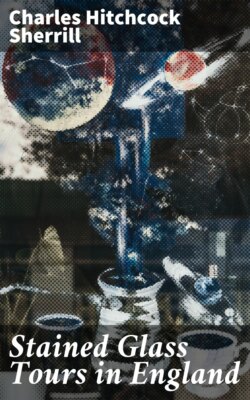Читать книгу Stained Glass Tours in England - Charles Hitchcock Sherrill - Страница 7
На сайте Литреса книга снята с продажи.
TOURS
ОглавлениеTable of Contents
Our glass-hunting tours will take us into almost every part of England. We shall go up and down the east coast cathedrals, from York in the north to Canterbury in the south-east. We shall also wander through the entire range of southern counties, and see the whole coast from Winchester, west through Salisbury and Exeter to St. Neot, far off in Cornwall, hard by Land’s End. But it will be in that corner of England which lies between Oxford and the Welsh border, that the greatest wealth of windows will be found. We shall arrange the tours so that the order in which the windows are viewed will conform chronologically with the stages of the craft’s development. It will, of course, largely depend on whether he elects to travel by rail, by automobile, or by bicycle, just how slavishly the pilgrim follows the order in which the towns have been set out. The trips have been arranged with an eye to geography rather than to railway time-tables—geography is so much more stable than “Bradshaw’s General Railway Guide”! The omission from the list of sundry important cathedrals, like Durham, Ely, Peterborough, Worcester, &c., is caused by the deplorable fact that all their ancient stained glass has been destroyed.
The order of towns is as follows:
| Early English Epoch | · | Salisbury, Canterbury, Lincoln, York. |
| Decorated Epoch | · | York, Norbury, Shrewsbury, Ludlow, Hereford, Tewkesbury, Deerhurst, Bristol, Wells, Exeter, Dorchester, Oxford. |
| Perpendicular Epoch | · | Oxford, Fairford, Cirencester, Gloucester, Great Malvern, Little Malvern, Ross, Warwick, Coventry, York. Salisbury. Winchester. St. Neot. |
| Renaissance Epoch | · | London, Cambridge, Lichfield, Shrewsbury. Guildford, Gatton, Knole. |
In selecting the order of the above itineraries, we have ended the first, or Early English period, at York, because that city is not only rich in early mosaic glass, but also in that of the Decorated period, thus making it most convenient for us there to begin the second or Decorated tour. In the same manner we have concluded the itinerary of the Decorated period at Oxford, for there are found not only Decorated, but also Perpendicular windows, thus permitting us to commence the Perpendicular tour in the same city which ends our Decorated one. York is set down as the last of the Perpendicular trip, but if our pilgrim has already visited that city on either the Early English or the Decorated tour, he will doubtless also have seen all of its Perpendicular glass, which will obviate the necessity for again making the long journey north. In that event, with York left out of the Perpendicular tour, it will prove to be much more condensed, both as to territory and distance, than either of the two earlier ones. The last, or Renaissance epoch, has but few examples in England, and these are so widely separated that it seems best to break them up into two tours. Of the seven places cited (London, Cambridge, Lichfield, Shrewsbury, Guildford, Gatton, and Knole) the best English glass is at London and Cambridge, while that at Lichfield is Flemish, and most of that at Shrewsbury German.
For tables of distances, &c., see pp. 251-254.
